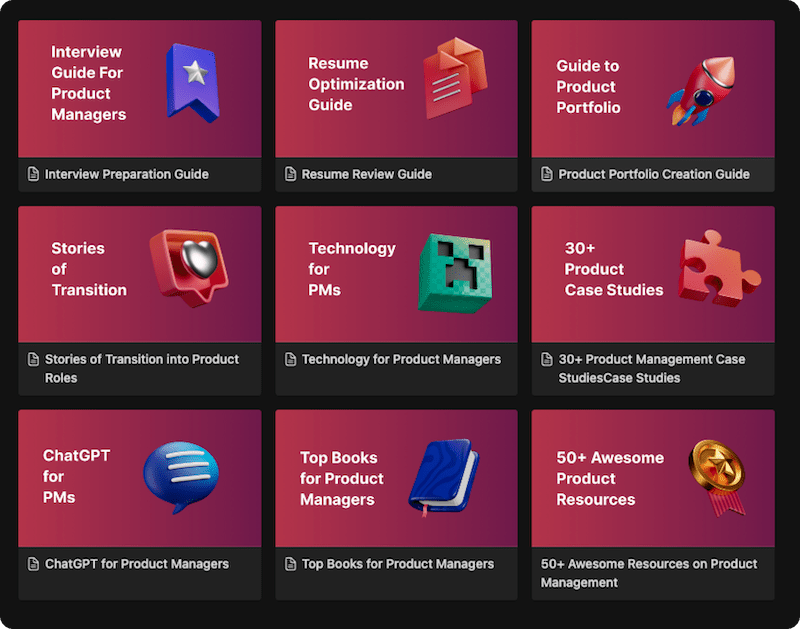As a product manager, have you ever been in a Feature Kickoff meeting where the team is excited about a new idea, but you have a nagging feeling that you’ve lost sight of the customer’s actual problem? It’s a common scenario: teams fall in love with their solutions and features, creating a product that is technically impressive but ultimately fails to connect with the user. The graveyard of failed products is filled with solutions looking for a problem. To avoid this fate, you need a tool that rigorously connects what you’re building to the real-world needs of your customers. This is precisely where the Value Proposition Canvas becomes your most trusted ally.
This guide is designed to make you a master of the Value Proposition Canvas. We will break down this powerful strategic tool from its foundational concepts to its practical application, ensuring you can use it to build products that resonate deeply with your target audience. You will learn not just the “what” and “why” of the canvas, but the step-by-step “how,” enabling you to facilitate workshops, challenge assumptions, and confidently lead your team toward achieving that elusive, all-important Product-Market Fit.
Definition & Origin: A Tool from Strategyzer
The Value Proposition Canvas was created by Dr. Alexander Osterwalder, a Swiss business theorist and entrepreneur, as a companion to his wildly popular Business Model Canvas. It was first detailed in his 2014 best-selling book, Value Proposition Design, co-authored with Yves Pigneur, Greg Bernarda, and Alan Smith.
Osterwalder developed the canvas to address a common weakness he observed: companies struggled to articulate exactly how their products created value for customers. The Value Proposition block in the original Business Model Canvas was often filled with vague ideas. The Value Proposition Canvas provides a dedicated, structured “plug-in” that forces teams to zoom in on this critical relationship between the customer and the product, making it an indispensable tool for anyone involved in Product Strategy.
Benefits & Use-Cases: The Strategic Advantage of the Canvas
For a product manager, facilitating a Value Proposition Canvas workshop isn’t just an exercise; it’s a strategic imperative with tangible benefits.
- Creates a Shared Understanding: The visual nature of the canvas ensures your entire Cross-functional Teams from engineering to marketing has a single, shared reference point for who the customer is and what they need.
- Reduces the Risk of Failure: By forcing you to validate your assumptions about the customer’s problems before you build, the canvas helps prevent you from building a product nobody wants.
- Drives Data-Driven Decisions: The canvas is a living document. It provides a framework for generating hypotheses that can be tested through user interviews, surveys, and A/B Testing.
- Improves Go-To-Market (GTM) Messaging: A completed canvas is a goldmine for the marketing team, providing the exact language needed to communicate the product’s benefits in a way that resonates with customers.
- Achieves Laser-Focus: It helps teams avoid the Feature Bloat trap by ensuring every feature on the Product Roadmap can be directly tied to a customer’s pain or gain.
How It Works: A Step-by-Step Guide to Using the Canvas
The canvas is split into two sides: the Customer Profile (the circle on the right) and the Value Map (the square on the left). The goal is to achieve a “fit” between them. Always start with the customer.
Part 1: The Customer Profile (The Circle)
This section is about building a deep understanding of a specific User Persona or customer segment.
- Step 1: Customer Jobs (Jobs to be Done)
- What it is: Describe the things your customers are trying to get done in their work or in their life. These can be functional jobs (perform a task), social jobs (gain status), or emotional jobs (feel secure).
- Questions to ask: What tasks are they trying to complete? What problems are they trying to solve? What needs are they trying to satisfy?
- Example (for a ride-sharing app): Get from point A to point B safely, get home after a night out, make it to a meeting on time.
- Step 2: Customer Pains
- What it is: Describe the negative emotions, undesired costs, situations, and risks that your customer experiences before, during, and after getting their job done.
- Questions to ask: What frustrates them? What obstacles stand in their way? What risks do they fear?
- Example: Long wait times for taxis, unreliable drivers, surge pricing surprises, safety concerns at night.
- Step 3: Customer Gains
- What it is: Describe the outcomes and benefits your customers want. This includes required gains (the car must work), expected gains (the car should be clean), desired gains (the app is easy to use), and unexpected gains (a free water bottle).
- Questions to ask: What would make your customer happy? How do they measure success? What would simplify their work or life?
- Example: A predictable arrival time, a simple payment process, a friendly driver, feeling safe and comfortable.
Part 2: The Value Map (The Square)
Now, you shift focus to your product and how it will address the customer’s profile.
- Step 4: Products & Services
- What it is: Simply list the products and services your value proposition is built around.
- Example: A mobile app that connects riders with nearby drivers.
- Step 5: Pain Relievers
- What it is: Describe exactly how your products and services alleviate specific customer pains.
- Questions to ask: How does your product eliminate your customer’s frustrations? How does it reduce their fears or risks?
- Example: Live driver tracking on a map (reduces wait time anxiety), upfront pricing (eliminates surge surprises), driver ratings and reviews (increases safety and reliability).
- Step 6: Gain Creators
- What it is: Describe how your products and services create customer gains.
- Questions to ask: How does your product create savings that make your customer happy? How does it produce outcomes they expect or desire?
- Example: Cashless payments (simplifies the process), estimated arrival times (helps with planning), a premium “black car” option (provides a desired status/comfort).
Step 7: Achieving Fit
The final step is to check for a fit between the two sides. Are your pain relievers directly addressing the most critical pains? Are your gain creators producing the gains that truly matter to the customer? This is where you connect the dots and ensure your product isn’t just a collection of features, but a true solution.
Mistakes to Avoid: Common Canvas Traps
- Mixing the Sections: A classic mistake is to list a “lack of a feature” as a customer pain. Pains should exist independently of your solution.
- Filling it Out in Isolation: The canvas is a tool for Stakeholder Alignment. It should be filled out in a collaborative workshop, not by one person alone.
- Forgetting to Validate: The canvas is a map of your assumptions. The next step is to get out of the building and validate these assumptions with real users through interviews, surveys, and Beta testing.
- Designing for a Vague “User”: A canvas is most effective when it’s created for a specific User Persona or customer segment.
Examples / Case Studies: Tesla
Let’s apply the Value Proposition Canvas to Tesla, targeting an “Early Adopter” persona.
- Customer Profile:
- Jobs: Commute to work, project an image of success and environmental consciousness, experience the latest technology.
- Pains: “Range anxiety” (fear of running out of power), high initial cost of electric vehicles, guilt about environmental impact from gas cars, boring driving experience.
- Gains: Feel good about reducing their carbon footprint, experience thrilling acceleration and performance, own a car that is also a cutting-edge tech product, impress friends and colleagues.
- Value Map:
- Products & Services: All-electric luxury vehicles (Model S, 3, X, Y), Supercharger network, Autopilot software.
- Pain Relievers: Long-range batteries and an extensive Supercharger network (relieves range anxiety), over-the-air software updates that improve the car over time (justifies cost), zero emissions (eliminates environmental guilt).
- Gain Creators: “Ludicrous Mode” acceleration (creates a thrilling driving experience), minimalist high-tech interior with a giant touchscreen (delivers a cutting-edge tech feel), sleek design and strong brand (projects an image of success and innovation).
Related Concepts & Comparisons
Value Proposition Canvas vs. Business Model Canvas
- The Business Model Canvas is a strategic tool for describing, designing, and challenging your entire business model. It has nine blocks, including customer segments, revenue streams, and key partners.
- The Value Proposition Canvas is a “zoom-in” on two of those blocks: the Customer Segments and the Value Propositions. It does not replace the Business Model Canvas; it complements it by providing a more detailed look at the core of the business: the product-customer relationship.
Value Proposition Canvas vs. Lean Canvas
- The Lean Canvas, adapted by Ash Maurya, is a variation of the Business Model Canvas specifically for startups. It replaces some of the original blocks with startup-focused concepts like “Problem,” “Solution,” “Key Metrics,” and “Unfair Advantage.”
- While both are useful for startups, the Value Proposition Canvas is more narrowly focused on achieving Product-Market Fit, whereas the Lean Canvas is about finding a viable business model.
Conclusion
The Value Proposition Canvas is more than just another framework to add to your product management toolkit; it’s a fundamental shift in perspective. It forces you to stop thinking about your product in a vacuum and start seeing it through the eyes of your customer. By creating a disciplined, visual, and collaborative process for mapping your user’s world to your solution, you build a powerful foundation for a successful Product Strategy. This clarity becomes the guiding light that aligns your team, sharpens your focus, and dramatically increases the odds of building something people truly want and need.
As a product manager, your primary role is to represent the voice of the customer in every decision. The Value Proposition Canvas is your most effective tool for capturing, understanding, and championing that voice. Use it to challenge your own biases, to ground your team’s creativity in real-world problems, and to transform your value proposition from a marketing slogan into the living, breathing heart of your product. Don’t just build features; build a solution that perfectly fits the needs of your customer.
FAQ’s
You should have a diverse, Cross-functional Teams. This includes the product manager, a Product Designer, an engineering lead, a marketing representative, and someone from sales or customer support.
The best information comes directly from users. Use qualitative research methods like user interviews, contextual inquiries, and data from your Voice of Customer (VOC) program. Supplement this with quantitative data from surveys and Product Analytics.
Yes. A single product may serve multiple customer segments, and each will have different jobs, pains, and gains. Creating a separate canvas for each of your primary **User Persona** is a best practice.
The canvas is a map of your hypotheses. The next step is to prioritize the most critical assumptions and design experiments to test them. This is the core loop of Lean Development: Build, Measure, Learn.
Learn better with active recall quiz
How well do you know What is a Value Proposition Canvas? Let’s find out with this quick quiz! (just 10 questions)


